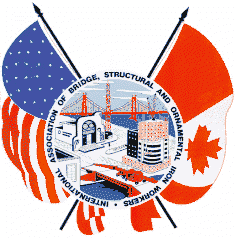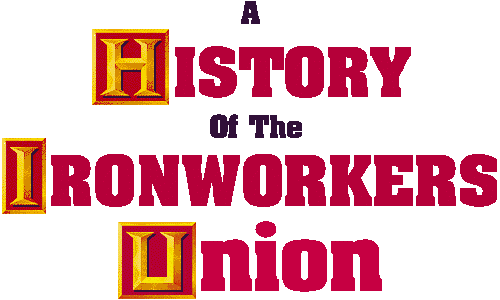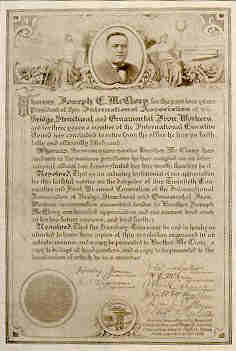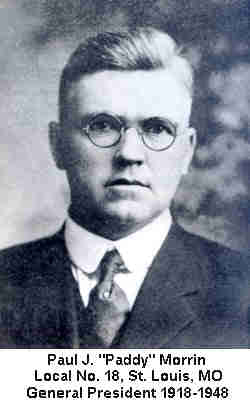|
|
|
|||
|
Our History
A Union is Born
The Turbulent Years
The Conspiracy Trials
The Beginning of the
Morrin Era
The Depression and a New
Deal For Labor
World War II
Ironworkers Grow in the
1950's Part Two Part Three
John H. Lyons Jr.
Elected President
The Tradition Continues
Pathways to the 21st
Century Under The Leadership of General President Jake West
|
Part One
Morrin, like many early
Ironworkers, was not originally an urban man. One of eight children,
he was born on a farm in Iowa County, in southeastern Iowa on August 21,
1879. In most large Irish Catholic He worked diligently at the trade and also applied himself on behalf of the local union. His active union interest was rewarded by election to several local offices including, President, Secretary/Treasure and Business Agent. As a delegate representing Local No. 18, he was immersed in affairs of the International during conventions. He served as a General Vice President prior to being the sixth man to head the International Association. On December 14, 1918, two and a half months after his election as General President, Paul J. Morrin wrote to John J. McNamara at San Quentin, a friendly letter (they were good friends). Morrin offered help and that of the International Association in securing McNamara's and his brother's liberty. Morrin was troubled by what he, and others in and outside of the trade union movement considered the excessive sentences levied against the brothers, especially since the deaths caused by the Los Angeles Times explosion were accidental and not premeditated. McNamara was delighted and moved by Morrin's thoughtful and warm letter. His response, dated December 30, 1918, informed Morrin that a few friends and some well meaning meddlers were planning to hire Clarence Darrow and attorneys of Darrow's choice to sue for McNamara's release. McNamara did not want Darrow to be involved. McNamara, ever direct, wrote, "My position is that if our officials are capable of paying the freight, they are capable of choosing the persons to whom it is to be paid. Can you see anything wrong with that attitude?" In the meantime, other indictments may have been pending against McNamara in California as Morrin indicated in a letter to his friend on April 7, 1919. He also tried to comfort him and reminded McNamara, "I know that these delays are aggravating to you, as I understand from personal experience how you feel." ( A reference to the time Morrin spent in Leavenworth for his conviction in the dynamite transport conspiracy). McNAMARA IS RELEASED Morrin and former Secretary/Treasurer John J. McNamara continued to correspond until McNamara's release from San Quentin Prison was imminent. McNamara served less than ten years of his fifteen year sentence. He was granted freedom on May 10, 1921, at forty-four years of age. His brother James B., was not so fortunate. His sentence was never commuted. He spent the last thirty years of his life behind bars. Except for five years, all of his sentence was served in San Quentin. In 1936 he was transferred to Folsom Prison, a place without adequate medical care for his cancer infested body. State officials finally returned him to San Quentin three weeks before he died. God commuted his sentence on March 8, 1941 - he had done his penance.
Paul J. "Paddy" Morrin was destined to hold the office of General President for three decades. He recognized that if the Iron Workers were ever to win their fight against the big steel employers, they had to first solve their jurisdictional arguments inside the house of labor. He immediately set up committees to meet with the various trades. After a few months, negotiations with the Carpenters on the question of shipyard rigging was resolved, however all other issues remained stalemated. He sought to obtain a united front with all trades involved in bridge building in an effort to obtain greater strength in the fight with the employers. As this program was being assembled, it soon became evident that such an alliance was floundering on the issue of pile driving. There was no question that the dispute had to be settled. Not only had the pile driving dispute become an issue that prevented the Iron Workers from resolving many of the major problems they faced, it was evident that at the next convention of the Building Trades Department, further jurisdictional resolutions were to be introduced. The question was of major importance, far beyond the question of the New York Dock Builders that had brought it to a head. In the ensuing years from the introduction of steel H-beams and reinforced concrete piling, every Iron Workers local was performing substantial pile driving. In fact, numerous local unions were made up exclusively of pile drivers. In the face of these facts, President Morrin took the only course open and reached an agreement conceding to the Carpenters all pile driving, except that done in connection with the erection of bridges. Such a settlement, in view of the substantial number of Ironworkers engaged in pile driving, was understandably received with indignation and outrage. President Morrin took the question to the membership. In local after local he told them that "the fight with the Carpenters was suicidal." After a few months concurrence was obtained. Local by local the Iron Workers relinquished their pile driving membership to the Carpenters and instructed their employers that no longer would they negotiate agreements covering pile driving. The related parts of the agreements were shortly finalized at the following convention of the Building Trades Department. The resolutions voiding the 1909 and 1913 jurisdictional decisions were recognized and accepted as being illegal and the jurisdiction again recognized to be that of the Iron Workers. The Lathers who, in the interim of years chartered many locals of reinforcing rodmen, were ordered to turn over all such members to the Iron Workers at the conclusion of every collective bargaining agreement which was in existence and not to seek to bargain for reinforced rodmen beyond the expiration of those agreements. The Lathers, who had devoted much time and energy in taking over the vacated Iron Workers jurisdiction, nevertheless saw the uselessness in becoming involved in the type of fight with the Building Trades Department of the A. F. of L. that the Iron Workers had just come through. One local, however, saw a loophole in the order. Prior to the expiration of the agreement between the Lathers in New York City and the employers covering rodmen, the agreement was reopened and extended. Each agreement thereafter was reopened before the expiration date and extended in a procedure that was to continue year after year until the arguments on the issue became academic. It is for this reason that the reinforcing rodmen in New York City were members of the Lathers International Union until 1979 when all Lather locals merged with the Carpenters except for Lathers Local No. 46, New York City, which became Ironworkers Local Union No. 46.
Scroll to the top and click on "The Beginning of the Morrin Era - 1918 to 1929 - Part Two"
[Home]
[Officers]
[Upcoming
Events] [Links
to Other Unions] |


 he
first Biennial Convention
and the Twentieth International
Convention of the Iron Workers was
held at the Adolphus Hotel in Dallas, Texas September 16th to 24th,
1918. This marked General President Joseph E. McClory's swan song
and the Election of Paul J. Morrin to
that office. Morrin was known by his nickname "Paddy"
to all his fellow Ironworkers and to
other trade unionists, as well. One month after the convention
Morrin's wife, Stella, died of pneumonia, a complication of influenza she
had contracted while nursing her husband, felled by the current
epidemic. The stricken Morrin was bed ridden and his doctor ordered
him not to attend his beloved wife's funeral. The bereaved and
deathly ill Morrin, unaccustomed to taking orders, had no option but to
acquiesce. This was not unusual for the time because the epidemic,
brought home by soldiers returning from World War I, was so bad in places
that the bodies were left in boxes at the curb to be picked up by wagons
and buried with no funeral. Worldwide, more people died from the
epidemic than were killed in the war.
he
first Biennial Convention
and the Twentieth International
Convention of the Iron Workers was
held at the Adolphus Hotel in Dallas, Texas September 16th to 24th,
1918. This marked General President Joseph E. McClory's swan song
and the Election of Paul J. Morrin to
that office. Morrin was known by his nickname "Paddy"
to all his fellow Ironworkers and to
other trade unionists, as well. One month after the convention
Morrin's wife, Stella, died of pneumonia, a complication of influenza she
had contracted while nursing her husband, felled by the current
epidemic. The stricken Morrin was bed ridden and his doctor ordered
him not to attend his beloved wife's funeral. The bereaved and
deathly ill Morrin, unaccustomed to taking orders, had no option but to
acquiesce. This was not unusual for the time because the epidemic,
brought home by soldiers returning from World War I, was so bad in places
that the bodies were left in boxes at the curb to be picked up by wagons
and buried with no funeral. Worldwide, more people died from the
epidemic than were killed in the war.
 families years ago, it was hoped that one son would enter the priesthood
and his parents entertained that idea about their son, Paul. Morrin
always stayed close to his church, however, he decided not to become a
priest. At nineteen years of age, he migrated two hundred miles to
St. Louis. Within a year he got into ironwork. He served a two
year apprenticeship in St. Louis Local No. 18 and was classified as a
journeyman Ironworker on November 18, 1901.
families years ago, it was hoped that one son would enter the priesthood
and his parents entertained that idea about their son, Paul. Morrin
always stayed close to his church, however, he decided not to become a
priest. At nineteen years of age, he migrated two hundred miles to
St. Louis. Within a year he got into ironwork. He served a two
year apprenticeship in St. Louis Local No. 18 and was classified as a
journeyman Ironworker on November 18, 1901. World
War I saw 1,467 Ironworkers drop their spud wrenches and pick up rifles to
defeat Germany - not quite ten percent of the total membership of over
17,000 at the end of the war. (Americans served through nineteen
months of combat to "eleventh hour of the eleventh day of the
eleventh month" of 1918. Most of the heavy American casualties
totaling 224, 089 men resulted from the fierce, relentless fighting of the
brutal last 200 days of the war, from April to November). The
Bridgemen's Magazine issues of the
era, show that members of the Union served their country willingly and
well.
World
War I saw 1,467 Ironworkers drop their spud wrenches and pick up rifles to
defeat Germany - not quite ten percent of the total membership of over
17,000 at the end of the war. (Americans served through nineteen
months of combat to "eleventh hour of the eleventh day of the
eleventh month" of 1918. Most of the heavy American casualties
totaling 224, 089 men resulted from the fierce, relentless fighting of the
brutal last 200 days of the war, from April to November). The
Bridgemen's Magazine issues of the
era, show that members of the Union served their country willingly and
well.